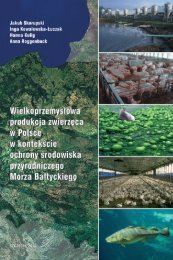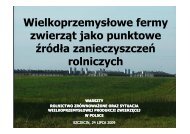best available technologies for manure treatment - Baltic Green Belt
best available technologies for manure treatment - Baltic Green Belt
best available technologies for manure treatment - Baltic Green Belt
You also want an ePaper? Increase the reach of your titles
YUMPU automatically turns print PDFs into web optimized ePapers that Google loves.
Best Available Technologies <strong>for</strong> <strong>manure</strong> <strong>treatment</strong> baltic sea 2020<br />
4: RESULT OF DATA ANALYSIS<br />
the produced livestock <strong>manure</strong> than can be<br />
contained within the P norms and P-index at the<br />
fields, where they spread their livestock <strong>manure</strong><br />
– see Table 8 It is important that both the liquid<br />
and the solid fractions are collected in ways<br />
that efficiently hinder seepage of effluents and<br />
evaporation of N compounds. It is likewise<br />
important to ensure, that possible use of<br />
floculation agents are made in compliance with<br />
EU legislation, and that used flocculation agents<br />
would not threaten human or animal health.<br />
• Anaerobic digestion (ref. no. 31) is justified<br />
through its positive effect on the field effect (recirculation<br />
of N in the agricultural production),<br />
the positive physical properties of the digestate<br />
being more homogenous and easier to apply<br />
precisely on the fields and bound to the soil,<br />
and its overall economy influenced by a smaller<br />
or larger income/value of the biogas itself, as well<br />
as positive side effects such as minimised need <strong>for</strong><br />
the farms to purchase N fertiliser, and positive<br />
effect on the climate accounts. Anaerobic digestion<br />
plants will, in case they are established as<br />
community plants, further serve as regional<br />
centres <strong>for</strong> an environmentally safe redistribution<br />
of livestock <strong>manure</strong>, so that the digestate can be<br />
used in a balanced way as fertiliser of crops. The<br />
technology is a stand-alone technology, but can<br />
be combined with any of the other selected<br />
<strong>technologies</strong> on the reduced list. The technology<br />
can be implemented as an on-farm as well as an<br />
off-farm technology. Due to the considerable<br />
positive effects of anaerobic digestion <strong>for</strong> the entire<br />
society, as well as due to the scale of economy in<br />
anaerobic digestion, society should be encouraged<br />
to take steps to establish community plants <strong>for</strong><br />
anaerobic digestion of livestock <strong>manure</strong>s.<br />
• Management measures (ref. group no. 110),<br />
including introduction (in all target countries)<br />
of official norms <strong>for</strong> P fertilisation, of a P-index,<br />
and of a demand <strong>for</strong> certification of persons<br />
dealing with transport and/or spreading of livestock<br />
<strong>manure</strong>s. P fertiliser norms and the P-index<br />
will in combination directly avoid over-fertilisation<br />
with P in relation to the capacity of the field<br />
and the crop to consume the applied P. The<br />
certification of persons will ensure their familiarity<br />
with good practices as well as standards,<br />
norms and rules in relation to their work, and is<br />
expected to give less risk <strong>for</strong> spill of livestock<br />
<strong>manure</strong>s in the environment due to un-awareness<br />
or accidents, as well as a more precise application<br />
on the fields according to plans. The relevance of<br />
certification is among other emphasized by the<br />
fact that a simple search of the Danish word<br />
“gylleudslip” (In English: slurry spill) on Google<br />
gives 32.800 hits.<br />
It is emphasized,<br />
1. that the list of the most relevant and costefficient<br />
livestock <strong>manure</strong> handling <strong>technologies</strong><br />
well could change if other criteria were used <strong>for</strong><br />
the drawing up of the reduced list of <strong>technologies</strong>,<br />
or if more in<strong>for</strong>mation became <strong>available</strong> to validate<br />
their environmental impacts and costefficiency<br />
in relation to leaching reduction. It<br />
is also important, that the selection of technology<br />
principally shall be made on basis of the situation<br />
<strong>for</strong> the individual farm.<br />
2. that the impact of <strong>manure</strong> <strong>treatment</strong> <strong>technologies</strong><br />
on leaching often is dependent on the<br />
management of the <strong>technologies</strong> and on the way<br />
different <strong>technologies</strong> are combined. The leaching<br />
reduction effect of a technology should there<strong>for</strong>e<br />
not be seen in isolation – <strong>for</strong> instance the<br />
potential positive effects of separation should not<br />
be outweighed by run-off and evaporation due to<br />
in-responsible storing and transporting of the<br />
fibre fraction.”<br />
4.1.9: Interesting <strong>technologies</strong> that needs<br />
further research and policy adaptation<br />
There are three <strong>technologies</strong> <strong>for</strong> treating of the<br />
separated fibre fraction that is suggested to be further<br />
researched and politically considered, namely drying,<br />
possibly followed by pelletizing, combustion and<br />
thermal gasification (technology reference numbers<br />
42, 43 and 44). The <strong>technologies</strong> are to some extent<br />
proven, also on commercial scale, but it is with<br />
reference to Annex E suggested that their environmental<br />
and economic per<strong>for</strong>mances especially are<br />
researched in case of fibre fractions from pig slurry.<br />
34








